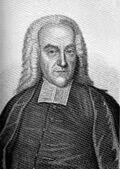the Fourth Week after Easter
Click to donate today!
Bible Commentaries
Bengel's Gnomon of the New Testament Bengel's Gnomon
Old Testament
Johann Albrecht Bengel (1687-1752) was a distinguished German Lutheran theologian and biblical scholar, renowned for his work in New Testament textual criticism. His contributions to biblical scholarship were groundbreaking, laying foundational stones for the critical study of the New Testament text that would influence generations of scholars to come.
Bengel was born in Winnenden, W�rttemberg, and pursued his theological studies at the T�binger Stift in T�bingen, where he was deeply influenced by the Pietist movement, an evangelical trend within Lutheranism that emphasized personal piety and a heartfelt relationship with God. This spiritual orientation deeply colored Bengel's approach to biblical studies, blending rigorous academic analysis with a devout Christian faith.
Perhaps Bengel's most significant contribution was his "Gnomon Novi Testamenti" (1742), a detailed commentary on the New Testament that sought to unlock the nuances and depths of the text with concise and insightful annotations. The "Gnomon" was notable for its emphasis on the original Greek text, its careful attention to grammatical details, and its devotional quality, making it both a scholarly resource and a guide for personal spiritual reflection.
Bengel was also a pioneer in the field of textual criticism, advocating for the importance of understanding the history of the New Testament manuscript tradition to discern the most authentic text. His approach was methodical and innovative, introducing the concept of textual families or recensions, which would later become central to the discipline.
His work had a profound impact on the study of the New Testament, influencing subsequent scholars and critics. Bengel's legacy is that of a scholar who, with piety and precision, sought to uncover the true meaning of the biblical text, thereby enriching both the academic study of the Bible and the spiritual life of the reader. His blend of scholarly rigor and devout faith set a benchmark for future generations in the field of biblical studies.
